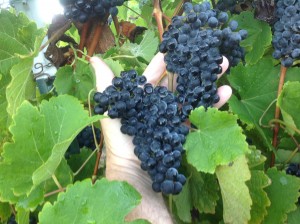New Grapes Revolutionize Midwest Wine
‘Why didn’t someone take the Cabernet Sauvignon grape and cross it with Norton to create a grapevine that could withstand Midwestern winters yet make a world class wine?”
That was the question that puzzled Lucian Dressel from the time he reopened the historic Mount Pleasant Winery in Augusta, Missouri, in 1967 until he sold it in 1992.
During those 25 years, Dressel experimented with dozens of different varieties of grapes, and while many made very acceptable wine, none really came up to the very highest quality levels of Cabernet Sauvignon, Cabernet Franc, or Sauvignon Blanc.
After selling the winery Dressel moved to Davis, California and quite by accident found himself living on the same road as Dr. Harold Olmo, arguably the most famous grape breeder of the 20th Century. Dr. Olmo was a professor emeritus from U.C. Davis, the most renowned university in the world when it comes to grape growing and wine making.
Although Dressel was a professional grape grower and winemaker, he knew nothing about grape breeding, so he picked up the telephone, gave Professor Olmo a call, and drove over to his house for what would be the first of many meetings to discuss the ins and outs of breeding grape vines.
Few people breed grape vines, and for good reasons. Grape flowers are extremely small, thus the manipulation of the flowers has to be done with a bent pin and a magnifying glass. Also there are only about ten days each year when breeding can be done. In the end, there’s no guarantee that any good vines will be the result, and if fortune does smile upon the breeder, then it may takes years, and sometimes decades, to see the fruits of one’s labors.
With lots of advice from Dr. Olmo, lots of good luck, and the perfect spring weather of Davis, California, by 2002 Dressel had produced a few dozen seedlings that looked very promising. There was one big problem, however. Although Davis was a virtual paradise for breeding grape vines, it was also a lousy place to test them for disease resistance and winter hardiness, since winter temperatures in Davis rarely dip below freezing and there are no summer rains or diseases. Dressel knew that he, and his new Cabernet-Norton crosses, would have to go east of Eden if they were ever to prove themselves under the harshest of conditions.
At that crossroad, fate smiled on Dressel and he had the chance to return to the St. Louis area and resume his career as a grape grower and wine maker. He planted the new vines and by 2007 had done sufficiently vigorous testing under adverse conditions to begin selling the vines nationwide to other growers. Two vines were standouts: a red named Crimson Cabernet, and a white variety named Cabernet Doré. Both were Cabernet Sauvignon crossed with Norton. Both had the winter hardiness and disease resistance of Norton, yet both produced wine that was totally French in character.
The most frequently asked question Dressel gets is: How can you get a white grape from two red grapes? ‘It’s all in the genes,”is his reply. ‘Cabernet Sauvignon has one red parent, which is Cabernet Franc, and one white parent, Sauvignon Blanc. Norton also has one red parent, an American vine, and a European parent that was almost certainly a white variety. When we did our breeding, we found that about half our seedlings would come up as white grapes. I love the fact too that using Cabernet Sauvignon as a parent lets us dip into the DNA not only of Cabernet Sauvignon, but Cabernet Franc and Sauvignon Blanc as well. In fact our vine Cabernet Doré makes a wine that is virtually indistinguishable from an outstanding French Sauvignon Blanc.”
There are now hundreds of acres of Crimson Cabernet being grown in 26 states from coast to coast, including California. A half dozen wineries have Crimson Cabernet wine for sale, the most recent release being by the Oliver Winery in Bloomington, Indiana. ‘This is a quantum leap for Midwestern wines”, Dressel added, ‘We can now produce our own world class dry wines and not have to rely on California fruit or wine to do it. In the future, these new vines will be the dominant ones in the Midwest. They are very happy growing here.
Dr. Diane Sol has a PhD. from U.C. Davis and worked in the grape and wine industry for Robert Mondavi, Christian Brothers and Domaine Chandon.



